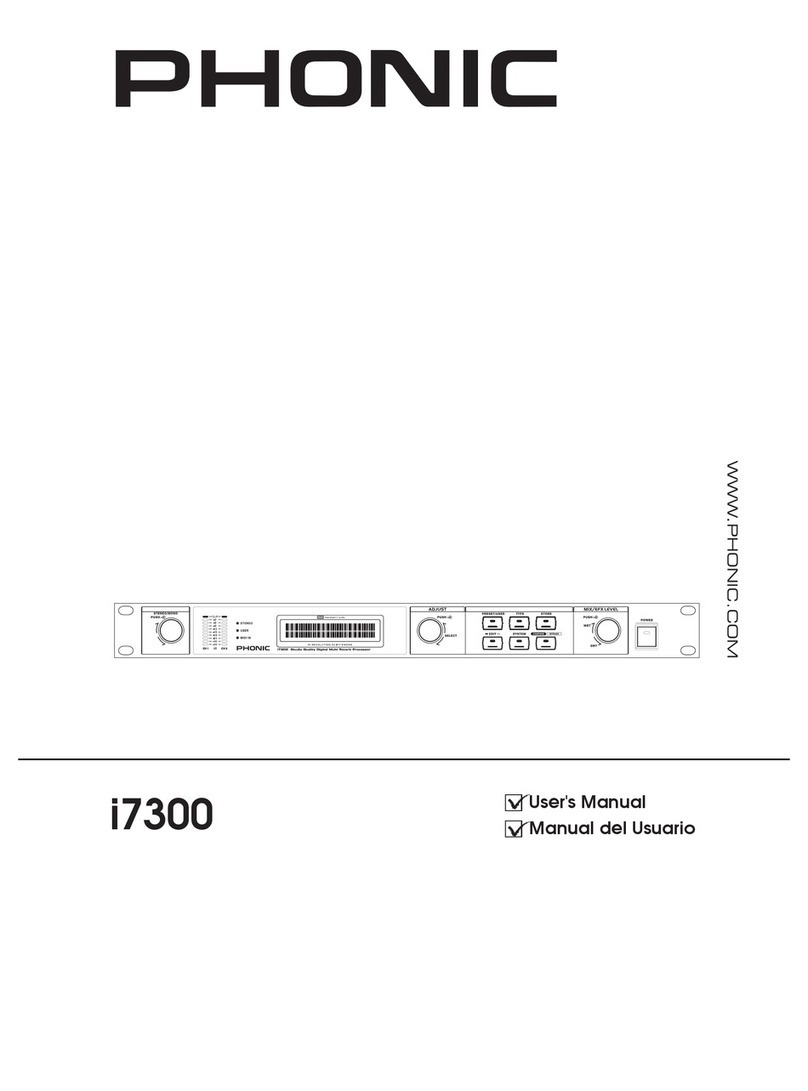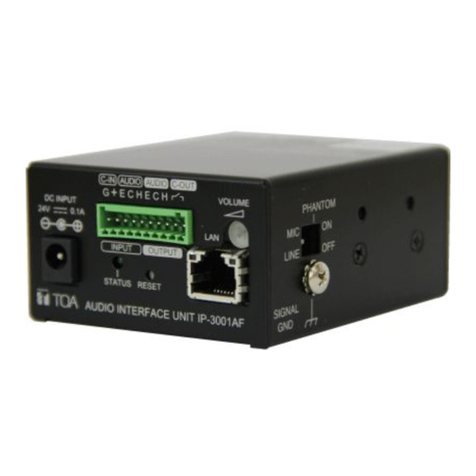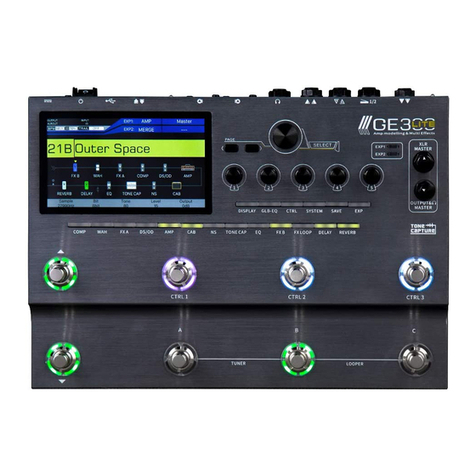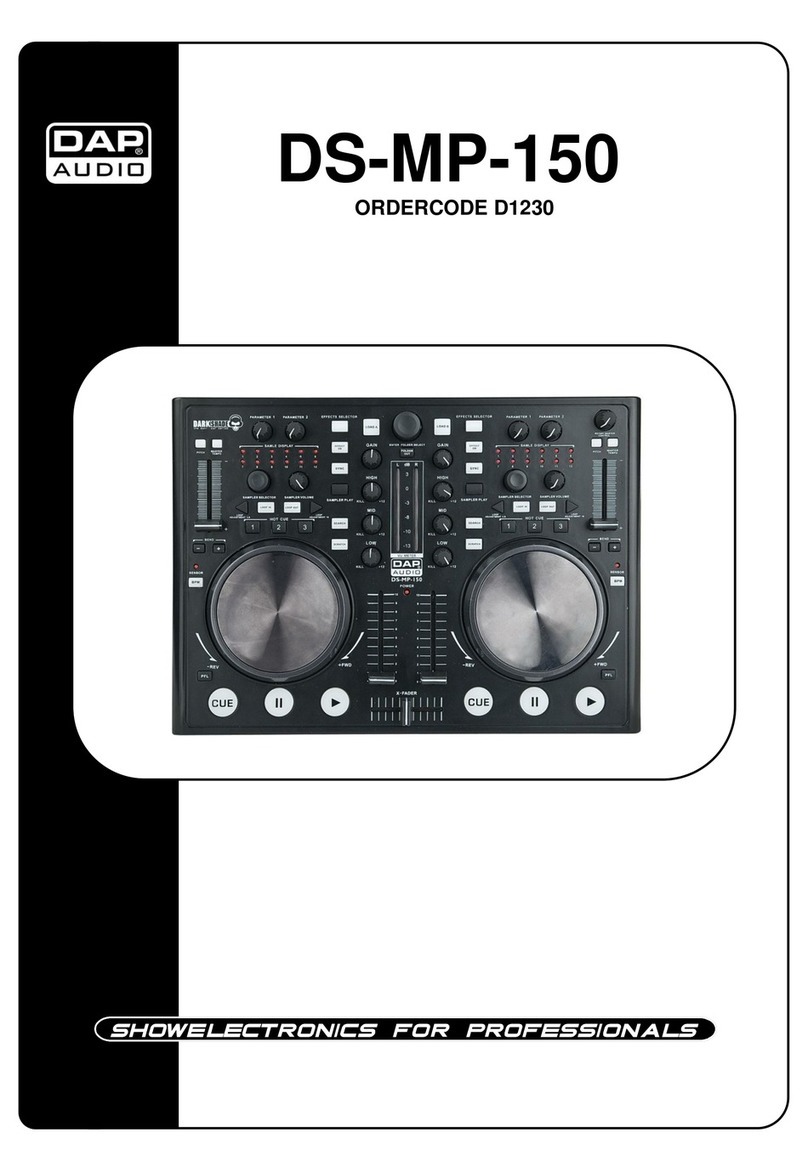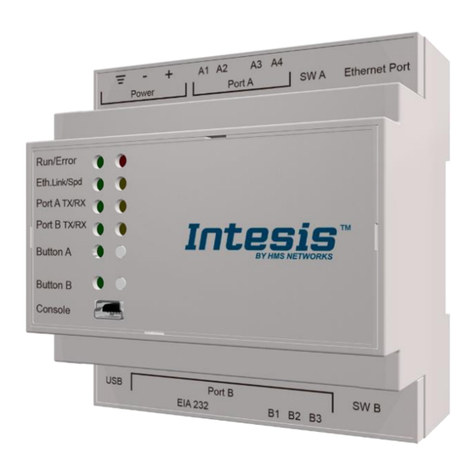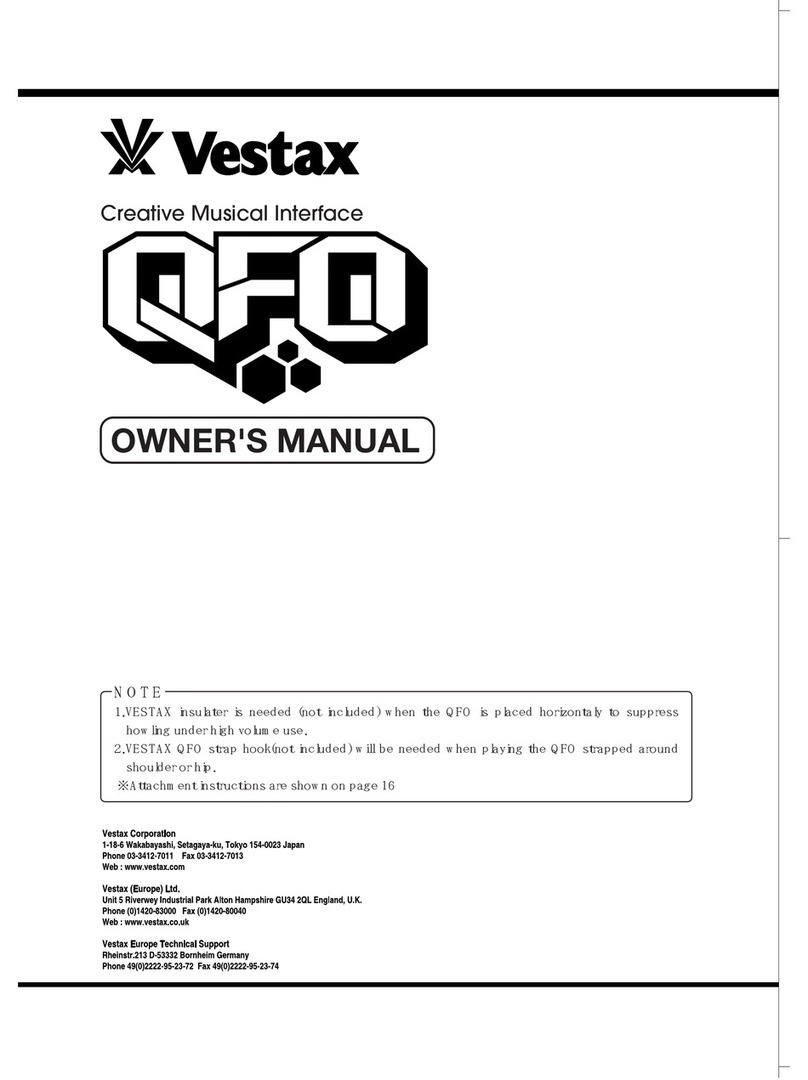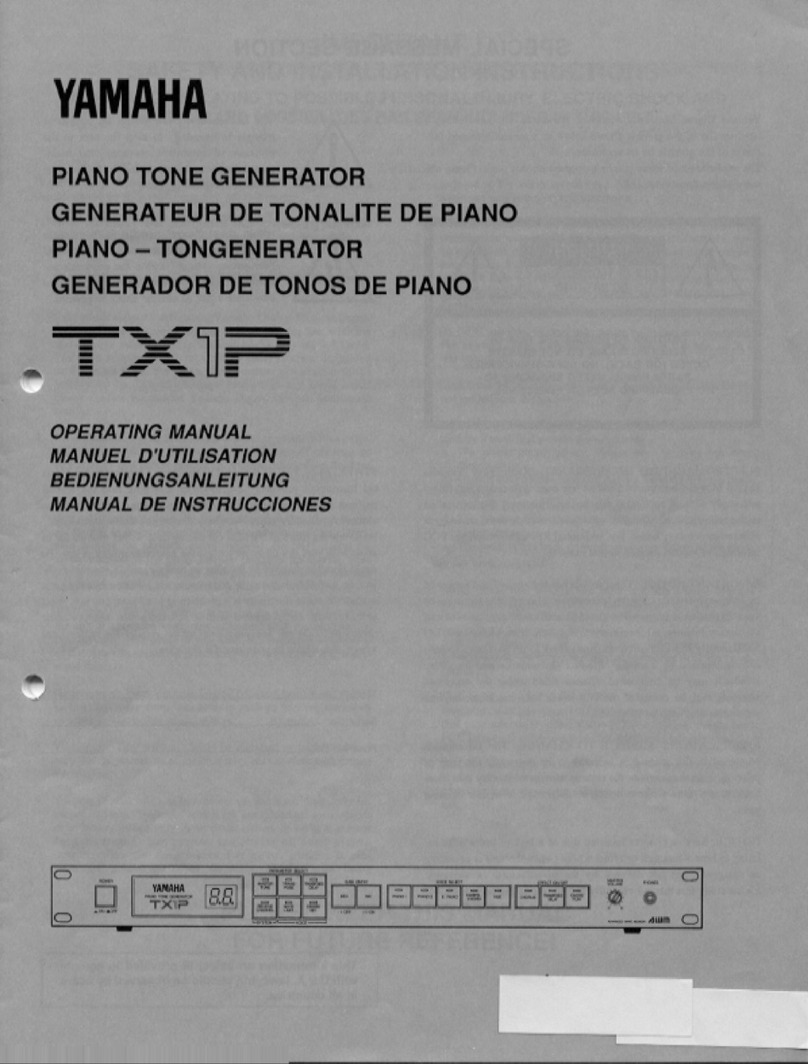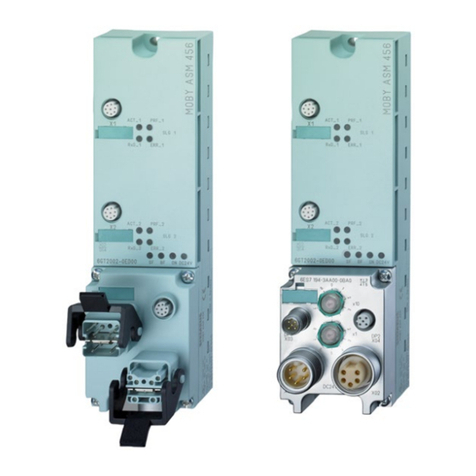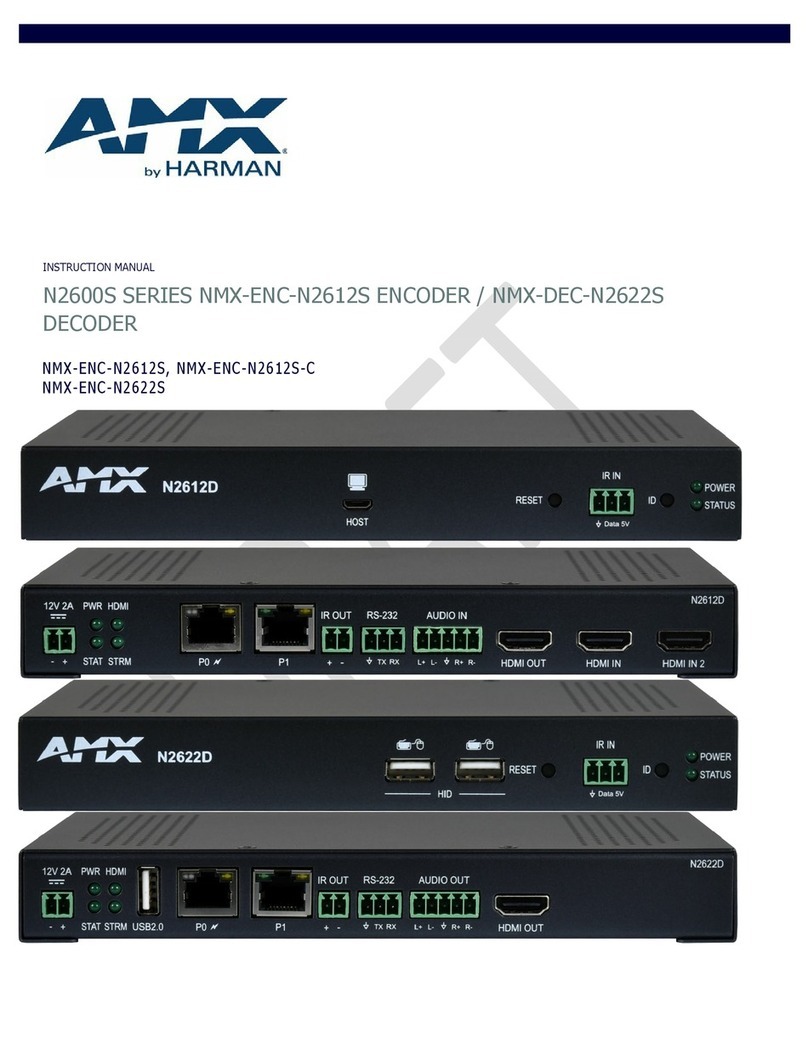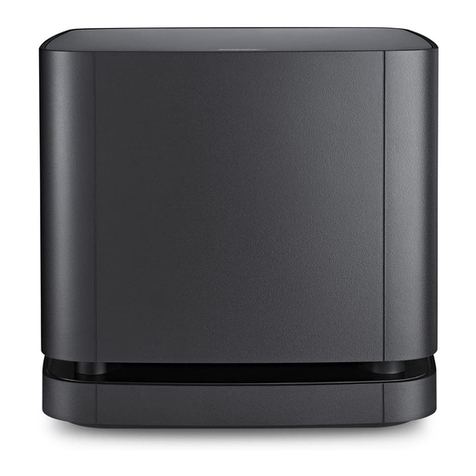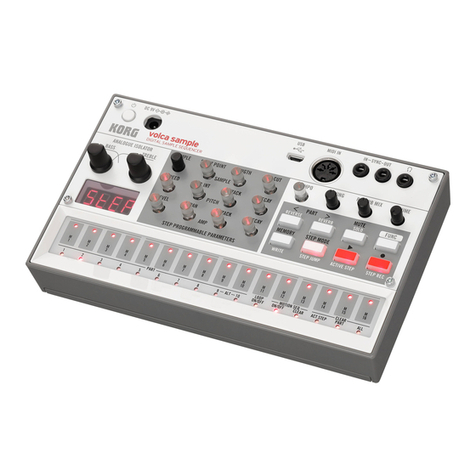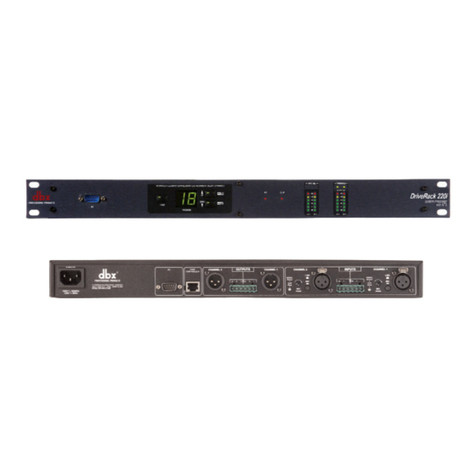Phonic Firefly 808 Universal User manual

Firey 808 Universal
FIREWIRE & USB INTERFACE

1. Read these instructions before operating this
apparatus.
2. Keep these instructions for future reference.
3. Heed all warnings to ensure safe operation.
4. Follow all instructions provided in this document.
5. Do not use this apparatus near water or in locations
where condensation may occur.
6. Clean only with dry cloth. Do not use aerosol or liquid
cleaners. Unplug this apparatus before cleaning.
7. Do not block any of the ventilation openings. Install
in accordance with the manufacturer
’
s instructions.
8. Do not install near any heat sources such as radiators,
heat registers, stoves, or other apparatus (including
.
9. Do not defeat the safety purpose of the polarized or
grounding-type plug. A polarized plug has two blades
with one wider than the other. A grounding type plug
has two blades and a third grounding prong. The wide
blade or the third prong is provided for your safety. If
the provided plug does not into your outlet, consult
an electrician for replacement of the obsolete outlet.
10. Protect the power cord from being walked on or
pinched particularly at plug, convenience receptacles,
and the point where they exit from the apparatus.
11. Only use attachments/accessories by the
manufacturer.
12. Use only with a cart, stand, tripod, bracket, or
table by the manufacturer, or sold with
the apparatus. When a cart is used, use caution
when moving the cart/apparatus
combination to avoid injury from tip-
over.
13. Unplug this apparatus during lighting
storms or when unused for long
periods of time.
14. Refer all servicing to service personnel.
Servicing is required when the apparatus has been
damaged in any way, such as power-supply cord or
plug is damaged, liquid has been spilled or objects
have fallen into the apparatus, the apparatus has
been exposed to rain or moisture, does not operate
normally, or has been dropped.
IMPORTANT SAFETY INSTRUCTIONS
CAUTION: TO REDUCE THE RISK OF ELECTRIC SHOCK,
DO NOT REMOVE COVER (OR BACK)
NO USER SERVICEABLE PARTS INSIDE
REFER SERVICING TO QUALIFIED PERSONNEL
The lightning flash with arrowhead symbol, within an
equilateral triangle, is intended to alert the user to the
presence of uninsulated
“
dangerous voltage
”
within the
product
’
magnitude to constitute a risk of electric shock to persons.
The exclamation point within an equilateral triangle is in-
tended to alert the user to the presence of important operat-
ing and maintenance (servicing) instructions in the literature
accompanying the appliance.
WARNING: To reduce the risk of or electric shock, do
not expose this apparatus to rain or moisture.
CAUTION: Use of controls or adjustments or performance
of procedures other than those may result in
hazardous radiation exposure.
The apparatus shall not be exposed to dripping or splashing and that no objects with liquids, such as vases,
shall be placed on the apparatus. The MAINS plug is used as the disconnect device, the disconnect device shall
remain readily operable.
Warning: the user shall not place this apparatus in the area during the operation so that the mains switch
can be easily accessible.
CAUTION
RISK OF ELECTRIC SHOCK
DO NOT OPEN

FIREWIRE & USB INTERFACE
FIREFLY 808 UNIVERSAL
INTRODUCTION .....................................................................................................................4
FEATURES..............................................................................................................................4
QUICK START / SET UP...........................................................................................................5
FRONT PANEL DESCRIPTION...............................................................................................6
REAR PANEL DESCRIPTION.................................................................................................7
FIREWIRE / USB INTERFACE...............................................................................................9
SYSTEM REQUIREMENTS..........................................................................................9
DRIVER INSTALLATION...............................................................................................9
CHANNEL ASSIGNMENT............................................................................................13
CUBASE LE 4...............................................................................................................13
PHONIC CONTROL PANEL SOFTWARE...................................................................14
FIREFLY MIXER SOFTWARE.....................................................................................16
STAND ALONE MODE...........................................................................................................18
APPLICATION ........................................................................................................................19
DIMENSIONS........................................................................................................................22
SPECIFICATIONS..................................................................................................................23
BLOCK DIAGRAM.......................................................................................................................24
APPENDIX ......................................................................................................................................25
Phonic preserves the right to improve or alter any information within this document without prior notice.
V1.0 MAY 27th,2008

4 FIREFLY 808 UNIVERSAL
INTRODUCTION
Congratulations on your purchase of one of the newest
members of the Firey series from Phonic, the Firey
808 Universal. We know how to make the best audio
gear for you and we know your need to create great
recordings and productions. The Firey 808 Universal
features a eight mic/line inputs (with +48V phantom
power), digital AES/EBU I/O and word sync, ADAT I/O,
MIDI I/O, S/PDIF I/O, and all of these with FireWire and
USB interfaces for digitally transferring your audio to
your computer in high resolution audio (up to 192kHz)
that meets today modern productions standards.
We know how eager you are to get started – wanting
to get the Firey out and hook it all up is probably
your number one priority right now – but before you
do, we strongly urge you to take a look through this
manual. Inside, you will nd important facts and gures
on the set up, use and applications of your Firey 808
Universal. If you do happen to be one of the many
people who refuse to read user manuals, then we just
urge you to at least glance at the Instant Setup section.
After glancing at or reading through the manual (we
applaud you if you do read the entire manual), please
store it in a place that is easy for you to nd, because
chances are there’s something you missed the rst
time around.
FEATURES
FireWire (IEEE 1394) & USB 2.0 audio interface
24-bit resolution, up to 192k Hz sampling rate
18 simultaneous inputs and outputs FireWire audio
interface
8 microphone preamps with trim controls and
individual phantom power switches
8 analog line Inputs including 2 Instrument Inputs
8 channels of optical ADAT I/O (4 ch. via 96k dual
SMUX)
S/PDIF I/O, AES/EBU I/O, MIDI I/O and word clock
I/O
Headphone output and Main output with volume
control for monitoring purpose
Channel meters on channel 1 to 8 for input or
output
Synchronization, sampling rate, digit I/O and MIDI
in/out indicators
Dual FireWire ports for daisy chaining and direct
connection to Mac or PC
Stand-alone mixer functionality for eld and studio
use without computer
Instrument input, pad switch, balanced TRS send
jacks on Inputs 1 and 2
Compatible with Windows XP, Windows Vista and
Mac OSX
Steinberg Cubase LE 4 software included

5
FIREFLY 808 UNIVERSAL
INSTANT SETUP
Quick Start
1. Install the USB or FireWire driver and mixer
software included with your Firey onto your
computer. More detailed instructions can be found
in the "Driver Installation" section of this manual.
Mac users do not need to install the drivers,
however have their own mixer software that can
ben installed to allow for adjustment of signal
levels, sampling rates and so forth.
2. During the driver installation process, you will be
instructed to connect the Firey to the computer
and turn it on. Connect the Firey to the computer
using the FireWire or USB cables included along
with the unit.
3. Connect the supplied AC power cable into the
power inlet connector at the rear back of the Firey
808. Turn the unit on using the power switch on the
front of the unit.
4. Connect a microphone to the XLR input connector
on the front of the unit. You can take a look at the
mic LED meter and adjust the level control so it
sits at a good level for recording. Do the same
with the various mic and line inputs on the rear
of the Firey. It's advisable to keep the unit off
when plugging in or unplugging microphones,
instruments and such.
5. Open the Phonic Control Panel software and
check that the Firey's inputs and outputs are all
shown in the appropriate windows. In this section
you are also able to change the size of the buffer,
sampling rate and a few other properties.
6. You can use your headphones with the Phones
output to monitor your input and output audio on
the Firey.
7. Now you are ready to start designing high
resolution audio productions and ready to nd out
all the advantages of your brand new Firey.
Setup
1. If you have experience connecting our FireWire
products you’ll nd this setup familiar and easy.
2. Turn on your computer and be sure to have a
FireWire or USB port available.
3. Connect your Firey to an AC power outlet through
the provided AC power cable.
4. Connect the supplied FireWire or USB cable to a
port on the back of your Firey, and connect the
other end to your computer. You only need to
connect a single FireWire cord to your computer
– the second port on the Firey is to allow you to
daisy chain the Firey with additional Firey 808
Universals.
5. Turn the unit on using the switch located on the
back panel.
6. Your computer will automatically recognize the
Firey provided you have installed the appropriate
drivers (see the Quick Start section). You should
be able to view and edit your Firey’s channel
properties in the Phonic FireWire Control Panel
software.
7. Your next and nal step would be to activate the
Firey in your DAW software. Most programs will
make you open a project before you do so. Then
all you need to do is go to the “devices”, “tools”
or “properties” pull-down menu (depending on
your software of choice) - here you should nd an
option that allows you to view and change your
desired inputs and outputs and assign them to
your project's channels. Activate the Firey and
you're done!

6 FIREFLY 808 UNIVERSAL
Front Panel Description
1. Power Button
Push this button in to turn the Firey 808 Universal on.
When the unit is on, the button will light up.
2. FireWire LED
This LED will light up when a connection to the computer
is established through the FireWire interface.
3. Channel 1 and 2 Inputs
These two combo jacks allow users to connect either
balanced XLR 3-pin connectors, for dynamic or
condenser microphones, or ¼” TRS phone jacks for
instruments such as electric or bass guitars.
NOTE: When plugging line-level signals into the
combo jacks, disengage the PAD button to lower the
signal level to an acceptable degree.
4. Input Gain Controls 1 - 8
Turn these knobs clockwise to increase the microphone/
line input gain for the corresponding channels. You
have 50dB of gain to work with, but be sure not to
adjust it to a level that will make the input meter hit
the “clip” point. A good region to be in is about -6dB
– this will give you a greater signal level with enough
headroom to avoid clipping.
5. PAD selector
This button controls the input sensitivity for channels 1
and 2. Pushing this button in will attenuate the input
signal by 20dB, allowing you to connect a microphone
or instrument to the combo input jack.
6. +48V Phantom Power
Pushing one of these buttons will activate the +48V
phantom power for the corresponding channel,
allowing you to use condenser or ribbon microphones
(or other devices that require +48V) to work properly.
Activation of phantom power will be accompanied by
an illuminated LED. If you are not sure if your mic uses
phantom power, please refer to the microphone user’s
manual.
7. Headphone Output Jack and Gain Control
All the audio signals that are mixed inside the Firey
808 Universal can be monitored with headphones
through this jack. You can also use the corresponding
control to adjust the signal level.
8. Main Level Control
This control adjusts the nal level of the audio sent
through the main left and right outputs, the signal of
which is taken either from the FireWire return signal
or the various analog and digital inputs (depending on
your software settings).
9. LED Level Meter
This stereo 6-segment LED meter displays the signal
level of sum of all 8 analog input channels. User’s
are advised to keep this meter sitting around the -6dB
mark to make the best use of audio possible without
causing any unnecessary clipping.
10. Channel LED Level Meters
The input/output signal levels from analog inputs/
outputs 1 to 8 are shown in these 4-segment LED
meters. Whether these meters display the input or
output level is dependant on the input/output select
button. Users are advised to try and keep their signal
level around the -20, -10 marks, as to avoid distortion
and clipping.
11. Input/Output Select Switch and Indicator
This button determines whether the LED level meter
will display the input or output signal of the Firey
808’s input/output channels. This button is an easy
way to compare input and output levels. Depending
which setting is currently active, an LED will light up
next to the corresponding setting (“analog input” or
“analog output”).
1
2
34
6
5
78
9
11
10

7
FIREFLY 808 UNIVERSAL
12. Synchronization Indicators
Firey 808 Universal can be synchronized with any
WCLK sync device, enabling you to use it for your
audio/video recording studios as well as cinema and
video production that requires high resolution audio.
When the Firey 808 is synchronized, one of these
LEDs will light up to indicate which device the Firey is
currently synced with. If you try to sync with a device
not connected to the Firey, the corresponding light will
ash briey and return back to the previous setting.
13. Sampling Rate Indicator
When Firey 808 is synchronized, one of these LEDs
will light up to show the sampling rate of the device
the Firey is synchronized with. The Firey will
automatically be set to that rate.
14. AES/SPDIF LED Indicator
These input and output LEDs will light up when the
AES/EBU or S/PDIF interface is in use.
15. ADAT LED Indicator
You can use your optical devices in conjunction with
the Firey 808. When the ADAT optical connection is
in use, the input and output LEDs will activate to let
you know the connection is successful.
16. MIDI Indicator
When using the MIDI interface, these input and output
LEDs will light up.
Rear Panel Description
17. Line Input Channel 1 and 2
These input jacks allow users to connect line-level
devices, the signal of which is fed through the FireWire
interface, and sent directly out the channel 1 and 2
sends.
18. Channel 1 and 2 Sends
These outputs act as direct sends of the channel 1
and 2 inputs, allowing the signal to be used in other
devices.
19. Input Channels 3 to 8
Each of these channels features a balanced ¼” TRS
Line Inputs and can be used to connect any line level
device like CD players, DAT recorders. You can even
connect an analog mixer that does not have FireWire
interface to allow you to send that signal to the computer.
Also present are 3-pin XLR mic input connectors for
use with condenser or dynamic microphones.
20. Main Outputs
These ¼” TRS outputs will allow users to send the main
stereo mix of the Firey 808’s return signal to external
devices. The signals from analog channels 1, 3, 5 and
7 are sent through the left output, whereas the 2, 4, 6
and 8 signals are sent through the right output. When
the FireWire or USB interface is in use, users are able
to use the Mixer software's crossfader to select the
degree of the FireWire return signal and the analog
input signal that is sent to these outputs. The Main
outputs can be connected to active speakers, studio
monitors, or other mixers, depending on your needs.
13
14 15 16
17
18
20 19
12

8 FIREFLY 808 UNIVERSAL
21. Analog Outputs
These are balanced ¼" TRS line outputs with line
(+4dBu) level signals. Users are able to use these
outputs to get a stereo output channel from each pair
of odd and even numbered outputs, or even a surround
mix (5.2 or 6.2). Analog outputs 1 and 2 can be used
to send a stereo mix of your analog inputs or FireWire/
USB return signal, which is ideal for use with studio
monitors or subwoofers (if making a surround mix).
22. AES/EBU In/Out
This is a standard XLR AES/EBU digital interface that
lets you connect your digital AES-enabled devices to
your Firey. The IN or OUT LED on the front of the
Firey will light up when the inputs and outputs are in
use.
23. S/PDIF / AES IN Switch
This switch determines which of these digital inputs
will be used.
24. S/PDIF In/Out
This is a standard RCA S/PDIF Digital Audio Input/
Output that can be used with digital mixers, DAT
recorders, or any external device that uses the RCA
digital interface format. Please use a 75 ohm coaxial
cable with RCA plug when using S/PDIF. The most
common problems or glitches incorporated with S/
PDIF transfer are due to use of improper analog
cables. Users may also use these inputs for "High-
Speed" S/PDIF devices when that option is selected in
the computer's Firey mixer software.
25. FireWire / USB Ports and Select Switch
These connections are digital USB and FireWire (aka
IEEE 1394) ports that you can use to connect the
Firey 808 Universal to your computer. Doing so will
enable you to use your computer for high quality multi-
track recording, as well as editing, mixing, and so forth,
in your favorite Digital Audio Workstation Software.
The switch that accompanies these ports is used to
determine which of the ports you will be using.
You have two FireWire ports at your disposal; however
you need only connect one to your computer. The
second port will allow you to connect a second Firey
808 Universal, allowing twice the number of inputs!
26. MIDI In/Out
These inputs will allow you to send 16 MIDI channels
through the FireWire or USB interface to your
computer, as well as receive 16 back. These channels
will be present within the Firey Control Software, and
available for use in most MIDI-enabled programs.
27. ADAT In/Out
This is a standard TOSlink ADAT optical interface that
you can use in the same way as you would use your
typical ADAT devices. This input can also be used
for SMUX inputs when this option is selected in the
computer's Firey mixer software.
28. WCLK IN/OUT
These are BNC input/output connectors for standard
Word Clock Syncs, as are used in DVTRs and other
digital devices.
29. AC Power Input and Fuse Holder
Connect the supplied AC power cord to this connector.
The other end should be connected to a suitable
power supply. The power supply’s fuse is located just
below this connector. If your fuse blows, remove the
fuse holder’s cover and replace the fuse with another
suitable fuse (as indicated on the fuse-holder’s
cover).
AES IN
S/PDIF
IN
24 2223
28 27
29
21
26 25

9
FIREFLY 808 UNIVERSAL
FireWire / USB Interface
System Requirements
The following are the minimum required specications for use with the Firey 808 Universal. If your computer does not
meet these requirements, you will experience lagging of audio and possible freezing of your computer when attempting to
operate the device.
Windows
• Microsoft® Windows® XP SP1 and SP2 / Vista®
• Available USB 2.0 or FireWire port (suggested FireWire Interface: ADS Pyro 64 FireWire card with TI chip)
• Intel Pentium® 4 processor or equivalent AMD Athlon processor
• Motherboard with Intel or VIA chipset
• 5400 RPM or faster hard disk drive (7200 RPM or faster with 8 MB cache recommended)
• 512 MB or more of RAM (1 GB or more recommended)
Macintosh
• OS X 10.3.5 or later with native FireWire support
• G4 or newer processor
• 512 MB or more of RAM
Driver Installation
To use the Firey 808 on a PC, it is important to install all the necessary drivers from the included CD (ASIO and WDM driv-
ers). It is important that users read all instructions carefully before continuing on to the each step of installation, as users
will be required to unplug and plug in their FireWire device. These drivers are not necessary for Mac users, however Mac
users may wish to install our Mixer software from the included CD. It’s important to remember that the driver you install will
depend on whether you are using FireWire or USB, so make sure you install the right one!
Windows XP (with Service Pack 1 or 2) / Vista
1. It is recommended that you quit all applications before starting the installation process.
2. Ensure the Firey is not yet connected to your Computer’s FireWire or USB input.
3. Insert the installation CD included with your Firey into the CD-ROM drive of your computer. If the CD does not auto-
matically start the installation process within a few moments, then navigate to “My Computer” gyour CD-ROM drive g
“FireWire Drivers and Control Panel” or "USB Drivers and Control Panel" grun “setup.exe” to begin the installation manu-
ally. The Phonic Control Panel software and the Firey 808 Universal Mixer software will also be installed at this time.
4. Follow the installation instructions. The following applies to the USB driver installation, however the FireWire installation
is almost identical.
Make sure no other programs are running on your PC and that the
Firey 808 Universal is not connected to your PC, then click “Next”.

10 FIREFLY 808 UNIVERSAL
Read and accept the terms of the License Agreement, and click “Next” to continue.
Select a new destination for the installation, or else click “Install” to accept the default directory.

11
FIREFLY 808 UNIVERSAL
Connect the Firey to the Computer and turn the power on or, if
the Firey is already connected, turn it off and then on again.
If a message is displayed indicating that the software has not passed Windows Logo test,
click “Continue Anyway.” On Vista, you may receive a similar message regarding Signed Drivers.
After installation is complete, the Phonic Control Panel software will be visible
in the taskbar and you are free to use the device as they wish.

12 FIREFLY 808 UNIVERSAL
Macintosh OS X (10.3.5 or later)
The Firey 808 Universal works with the primary audio drivers of Macintosh OS X 10.3.5 and later. First verify that you
are running Macintosh OS X 10.3.5 or above, then connect the Firey to a FireWire port to the computer. To ensure your
Firey is working, enter the Utilities folder and double-click the Audio MIDI Setup icon.
Enter the Audio Device’s section. From the “Properties for” pull-down tab, select Firey 808. At the bottom of the window,
users can edit the setup of the Firey 808. Properties such as sampling rate and clock source can be altered and users
may also opt to make the Firey their default input and/or output device.
Mac users are able to use GarageBand, Logic Pro, as well as a host of other programs, in conjunction with the Firey 808
Universal.

13
FIREFLY 808 UNIVERSAL
Channel Assignment
When using a Digital Audio Workstation on a PC, and
within the included Phonic FireWire control panel soft-
ware, the following names have been attributed to the in-
put channels of the FireWire device. They can be altered
through the Phonic Control Panel software.
To alter an input channel’s name on your computer, open
the Phonic Control Panel software. On the left hand side
of the control panel, users will nd the settings categories.
By clicking “Input Channels”, the main window will display
the titles input channels. You can then highlight the channel
names and press the “Edit Channel Name” button on the
bottom of the control window. A new window will appear
that will allow users to enter a new name for the channel.
If you would like to use the Firey as your default audio
output device on your PC, simply go into the Windows con-
trol panel and select “Sound and Audio Devices.” Click on
the Audio tab and use the pull-down menu to select the
Firey 808 Universal from the list of available devices. The
Firey can also be selected as the default output device
for individual programs by editing said programs’ settings
/ options.
Cubase LE 4
Cubase LE is a fairly powerful program provided along
with the Firey interface that allows users to record, mix,
edit, delete, and alter their tracks. Please note that only
8 tracks can be recorded at once with the version of Cu-
base included, and users must upgrade to Cubase SX, or
nd other suitable DAW software, if they choose to record
more tracks.
Installation
Insert the Cubase LE 4 installation CD that came with
your Firey into the CD-ROM drive of your computer. Run
the installer. You must install Steinberg’s registration soft-
ware to be able to use the software successfully.
Setup
After successfully completing the installation process, the
following process must be followed to work efciently with
the Friey.
1. Open the Cubase LE 4 program and start a new Proj-
ect. Add a track or two to this project.
2. Go to the ‘Devices’ pull-down menu and select ‘Device
Setup’. On the left, select ‘VST Multitrack’.
3. From the ASIO Driver drop-down list select the “Phonic
ASIO Driver.” A pop-up box will ask you if you want to
switch the ASIO driver. Click ‘Switch.’ This completes
the basic installation and setup.
4. Activating audio tracks received from the Firey.
a. Go to the “devices” pull-down menu and select ‘VST
Inputs’. This will display the various inputs (“Phonic
FF808U Ch 1”, “Phonic FF808U Ch 2”, etc.)
b. Activate 8 of these channels by clicking the “Active”
button located next to each channel name. Please
note, only 8 input channels can be activated at any
one time in this version of Cubase. This is a limita-
tion of Cubase LE 4. If more input channels are
needed, we suggest upgrading to a higher version
of Cubase, or use other DAW software.
5. For further instructions on the operation of Cubase,
please consult the user manual by pressing F1 while
the program is open.
If you wish to reset the Phonic ASIO driver, simply go to
the ‘devices’ pull-down menu and select ‘device setup’.
Simply click “reset” and select the “Phonic ASIO Driver”.
Click ‘ok’ to continue and the Firey 808 should once
again become functional.
FireWire Input Channel Name Device Channel
Line[1] I L Analog Input 1
Line[1] I R Analog Input 2
Line[2] I L Analog Input 3
Line[2] I R Analog Input 4
Line[3] I L Analog Input 5
Line[3] I R Analog Input 6
Line[4] I L Analog Input 7
Line[4] I R Analog Input 8
SPDIF[1] I L S/PDIF or AES In
SPDIF[1] I R S/PDIF or AES In
TOS[1] I L ADAT or SMUX In
TOS[2] I R ADAT or SMUX In
MIDI I 1 MIDI In
FireWire Output Channel Name Device Channel
Line[1] O L Analog Output 1
Line[1] O R Analog Output 2
Line[2] O L Analog Output 3
Line[2] O R Analog Output 4
Line[3] O L Analog Output 5
Line[3] O R Analog Output 6
Line[4] O L Analog Output 7
Line[4] O R Analog Output 8
SPDIF[1] O L S/PDIF or AES Out
SPDIF[1] O R S/PDIF or AES Out
TOS[1] O L ADAT or SMUX Out
TOS[2] O R ADAT or SMUX Out
MIDI O 1 MIDI Out

14 FIREFLY 808 UNIVERSAL
FireWire Device Control Panel
The FireWire control panel can be accessed at any time
by entering choosing the shortcut from your Programs
menu. This program will not only allow users to alter their
device and channel names and properties, but will also let
them correct for latency issues, change sampling rates,
and so forth. When opening the software, a number of
options will be available for users to select from, allowing
them to adjust the available properties.
Devices
In the Devices section, users are able to view and edit the
name of the Phonic FireWire or USB Devices currently
connected to their computer.
Input Channels
The Input Channels section allows users to view and edit
the name of the various input channels received from the
FireWire or USB interface. For a list of default channel
names, please consult the table on page 13.
Output Channels
By entering the Output Channels section, users can view
and edit the names of the various output channels from
the computer to the Firey 808 Universal.
Synchronization
In the Synchronization section, users can adjust the sam-
pling rate and other synchronization properties. Many of
these adjustable properties, as they are, are set for opti-
mum performance and, unless you are sure of what you
need to change, are probably best left alone.
First off, the sync mode can be altered, though making
this alteration is not recommended for novice users. The
sync mode is basically the way the computer determines
what the ‘clock source’ (ie. device that your computer will
use to determine the timing of all digital signals received)
will be. The default setting for this feature is “CSP,” mean-
ing the Firey is the “master” clock source of the device.
The other options allow users to make the FireWire fol-
low the “timing” of whichever device is the clock source.
Having two clock sources has the potential to create very
undesireable results, so it is best avoided. If the Firey
is the only piece of digital audio equipment attached to
the computer, there is no reason this option should be
changed.

15
FIREFLY 808 UNIVERSAL
Users are also able to change between automatic and
manual sampling rate settings. When the sampling rate is
manually set, users can select between sampling rates of
44.1, 48.0, 88.2, 96.0 and 128 kHz per second for analog
inputs and 176.4 and 192.0 kHz per second for some digi-
tal devices. Many devices have sampling rates that do
not surpass 44.1 kHz per second, therefore, when using
multiple digital devices, users are advised not to exceed
this level unless they are sure the secondary device’s
sampling rate can.
Settings
Users are able to adjust various buffer times in the Set-
tings section.
The Stream Buffer Depth is adjustable between 0.5 and
20 milliseconds. It adjusts the buffer used when stream-
ing a signal from the Firey. If the depth is set too high,
an obvious latency will become evident. If the depth is
too low, various clicks and pops may become obvious. It
is best to set the Stream Buffer Depth to a level that al-
lows users to get the lowest latency, while still maintaining
an optimal performance. The default settings are ideal for
most computers.
The ASIO Buffer Depth is adjustable between 4 and 40
milliseconds. This allows users to adjust the latency of
the stream received by ASIO driver-based software (in-
cluding Steinberg Cubase LE 4).
The WDM (Windows Driver Model) Sound Buffer Depth
is adjustable between 4 and 40 milliseconds. This al-
lows users to adjust the latency of the stream received by
WDM based programs.
Also in this section, users are able to view their “drop out
statistics”, where the number of times the FireWire con-
nection has been interrupted can be viewed.
Streams
In the Streams section, the Firey device properties can
be viewed. Each input and output stream can be scruti-
nized, and the isochronous stream number and its sup-
ported sampling rates can be viewed.

16 FIREFLY 808 UNIVERSAL
Disconnected
Input Monitor Mixer
0.0 dB0.0 dB
Line1
M M
S S
Link
Line2
1
43
2
7
5
6
Outputs
0.0 dB
Master 1/2
10
8
9
When there is no digital audio workstation software is in
use, the Firey 808 Universal can be controlled using this
basic mixer which is included along with the driver and
control panel software. The signal from this mixing panel
is able to be fed back to the Firey 808 Universal as a
stereo signal, routed to analog outputs 1 and 2 and the
headphones output.
Channel Inputs
1. Mute Button
Pushing this button will mute the corresponding channel,
stopping it from being sent back to the Firey.
2. Solo Button
Use this button to solo the corresponding channel back to
the Firey allowing users to monitor the signal. The so-
loed channels will be sent to analog outputs 1 and 2 and
the headphones output on the Firey 808.
3. Link Button
Pushing this button will enable a link function, allowing
users to control two channels as if they were one with the
fader, mute and solo buttons being ‘linked’ to two inputs.
4. Pan
Each of the Firey’s inputs are set to either left or right by
default, with odd channels being set to the left, and even
channels being set to the right.
5. Fader
Click and hold the mouse button on the fader to adjust the
volume of the signal coming into the computer through
the FireWire/USB connection for each channel. When in
link mode, a single fader will control 2 channels simulta-
neously.
6. Level Meter
These two parts of the PC-based mixer give users an idea
of the input levels received through the FireWire/USB in-
terface. The graphic bar will give visual representation of
the level and users are able to read the exact input level
in decibels underneath the fader.
7. Channel Status (digital channels only)
This display window will show whether a digital device is
connected to or disconnected from the Firey unit. The
status will be updated automatically when a digital device
is connected to the correct inputs.
Output Channel
8. Balance
The balance control for the master output is set to the
center by default. Moving it to the left will attenuate the
right signal and intensify the left signal accordingly; mov-
ing it to the right will do the opposite.
9. Fader
Click and hold the mouse button on the fader to adjust
the volume of the stereo output signal being sent through
the FireWire/USB connection to the Firey. The signal
controlled by these controls is sent through the Firey’s
analog outputs 1 and 2.
10. Level Meter
This gives users an idea of the output levels of both
channels sent through the FireWire/USB interface. The
graphic bar will give visual representation of the level and
users are able to read the exact input level in decibels
underneath the fader.
Host Connection
11. USB / 1394a Selection
This indicator will light up in red to show whether the
USB 2.0 or FireWire interface is being used to access the
Firey 808 Universal.
Firey 808 Mixer Software

17
FIREFLY 808 UNIVERSAL
Sync Source
12. Device
Pushing this will allow you to use the Firey 808 Universal
as the sync source for all your digital gear.
13. Coaxial S/PDIF
Selecting this option will activate any coaxial S/PDIF de-
vice as the sync source for your digital gear. If no device
is connected to the S/PDIF input on the Firey 808, the
corresponding sync source LED on the face of the de-
vice will ash briey then return back to the previously
selected sync source.
14. Optical S/PDIF
Selecting this option will activate any optical S/PDIF de-
vice as the sync source for your digital gear. If no optical
S/PDIF device is connected to the TOSlink ADAT input on
the rear of the Firey 808 Universal, the corresponding
sync source LED on the face of the device will ash briey
then return back to the previously selected sync source.
15. Word Clock
This option will allow you to use a
word clock as your sync source.
If no word clock device is con-
nected to the BNC word clock in-
put on the rear of the Firey, then
the corresponding sync source
LED on the face of the mixer will
ash briey and then return back
to the previously selected sync
source. Please see the diagram
below for information on hooking
up a world clock as your sync
source.
16. PC
This is the default option, and allows you to use the PC
as the sync source. When set to PC, the corresponding
sync source LED on the front of the Firey 808 Universal
will light up.
Note: If ADAT and S/PDIF devices are not set to the same sync source,
the user will be prompted to correct the problem.
Digital I/O Select
17. S/PDIF
Selecting this option will allow you to use a S/PDIF or AES
enabled digital device with the Firey.
18. High Speed S/PDIF
If you connect a high speed S/PDIF product to the S/PDIF
connector on the rear of the Firey 808 Universal, click-
ing this option will allow you to use the output signal from
this device.
19. ADAT
Select this option to use the TOSlink ADAT inputs on the
rear of the Firey 808 Universal.
20. SMUX
By selecting SMUX as your digital input/output device,
you are able to connect a SMUX enabled product to the
“ADAT” TOSlink inputs of the Firey. The SMUX output
signal is typically 8 channel, however if you set the sam-
pling rate to 96 kHz, this is reduced to 4 channels.
Other Features
21. Sampling Rate Selection
Here you can select the sampling rate of the signal sent
to the computer. For most applications, you will be able to
select between 44.1, 48, 88.2 and 96 kHz. If you choose
ADAT as your digital input selection, you are then able
to select 44.1 kHz or 48 kHz. When using high speed S/
PDIF devices, you are able to select between 176.4 and
192 kHz sampling rates. If the 192 kHz sampling rate is
set, the Firey’s level meter will be disabled.
22. Crossfader
The mixing software’s crossfader allows users to adjust
the signal returned to the computer’s analog 1 and 2 out-
puts. When centered, the signal will be a 50-50 mix of
the pure signal received by the Firey 808 Universal and
the signal returned to the 808 from the computer. When
pulled to the left, the monitor signal from the 808 gradu-
ally becomes more dominant; when pulled all the way to
the left, this signal is the only signal audible. If this control
is pulled to the right, however, the stereo signal from the
mixing panel software will become more dominant.
Word Clock to Other Slave s
BNC T- Ad ap te r
World Clock from Maste r
Wor ld C loc k
IN
22
Input Monitor Mixer Main 1/2 - from PC
Cross Fader
- Sync Source -
- Host Connection -
- Digital I/O Selection -
- Sample Rate -
- ADAT -
ADA
SET
T ( 44.1 / 48 kHz)
SMUX ( 88.2 / 96 kHz)
SPDIF HS-SPDIF
Device
Coax SPDIF
Opt. SPDIF
Word Clock
PC
96.0 kHz
USB 2.0 1394a
12
11
13
15
18
20
14
16
17
19
21

18 FIREFLY 808 UNIVERSAL
Stand-Alone Mode
The Firey 808 Universal can work independently, without
any FireWire connection being established. The following
is just a couple of points of interest that you may need to
know to use the Firey in stand-alone mode.
Firstly, whatever settings you have made in regards to
digital inputs, outputs, and sampling rates while using the
Firey 808’s mixer software will be kept even after you
restart the device and/or disconnect the FireWire /USB
cable. This means whatever inputs and outputs you have
set will be activated/deactived as per your previous set-
tings. The default sampling rate is 44.1 kHz, and the de-
fault digital input/output is S/PDIF.
Also, the analog inputs are routed to their correspond-
ing analog outputs, as well as a mix of these inputs be-
ing sent through any digital outputs that have been set
(ADAT, S/PDIF, etcetera).

19
FIREFLY 808 UNIVERSAL
APPLICATION
Recording vocals (multi-part harmonies, choirs, etc.) or speeches
MICROPHONE MICROPHONE
COMPUTER
DIGITAL MIXER MULTI-TRACK RECORDER
MICROPHONESTUDIO MONITORS MICROPHONE MICROPHONE MICROPHONE MICROPHONE MICROPHONE
HEADPHONE
8 in, 8 out

20 FIREFLY 808 UNIVERSAL
Making studio recordings (without the studio)
MICROPHONE MICROPHONE
DRUM MACHINE
GUITAR EFFECT
GUITAR
KEYBOARD
MICROPHONE MICROPHONE
HEADPHOME AMP
HEADPHOME AMP HEADPHOME AMP HEADPHOME AMP HEADPHOME AMP
HEADPHONE
HEADPHONE
HEADPHONE
HEADPHONE
HEADPHONES HEADPHONES HEADPHONES HEADPHONES
GUITAR EFFECT
BASS
Other manuals for Firefly 808 Universal
1
Table of contents
Other Phonic Recording Equipment manuals
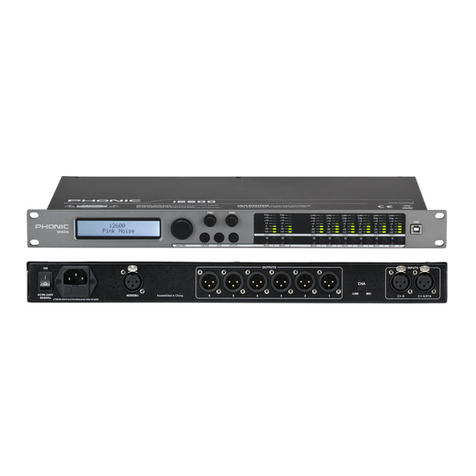
Phonic
Phonic i2600 User manual
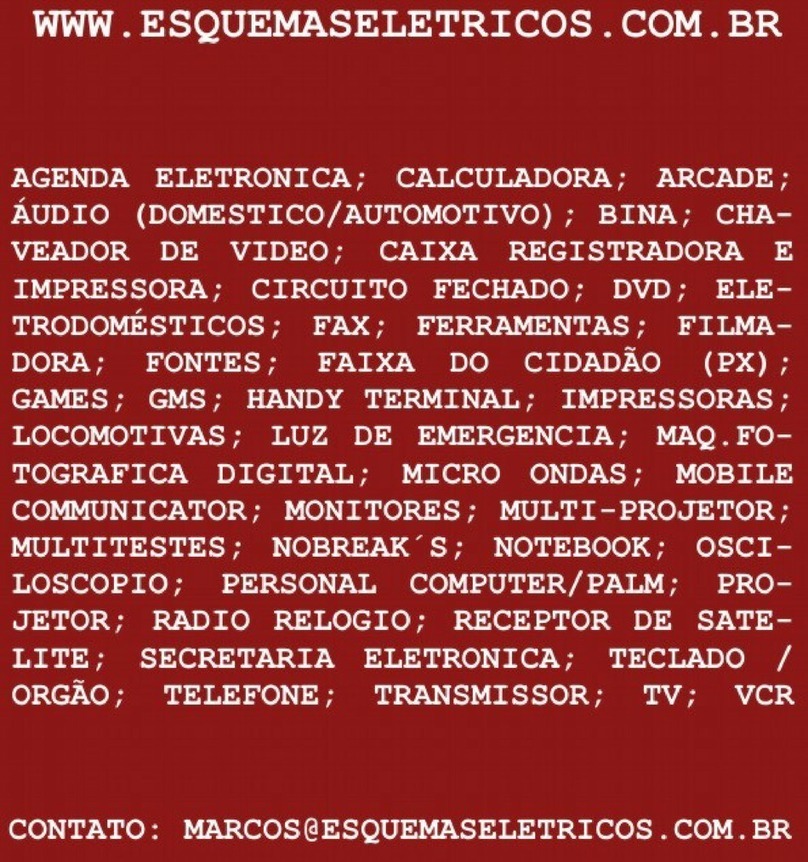
Phonic
Phonic MQ 3229 User manual
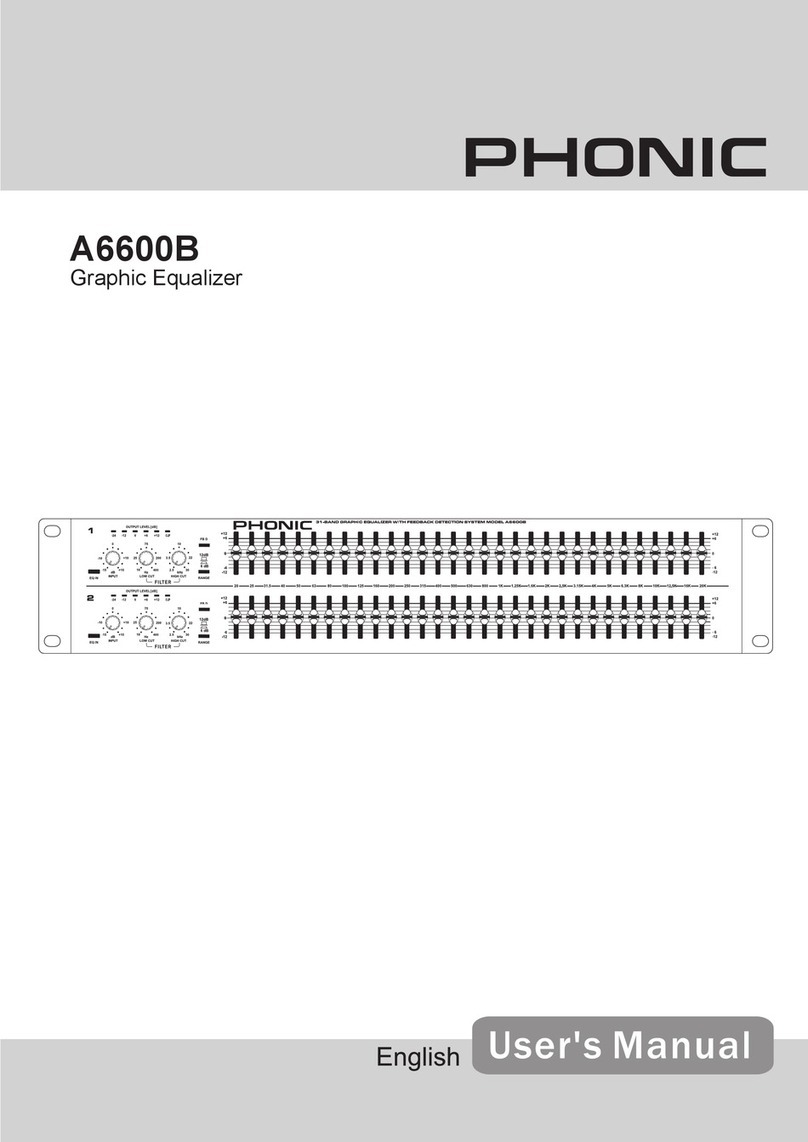
Phonic
Phonic A6600B User manual

Phonic
Phonic MQ3300 User manual
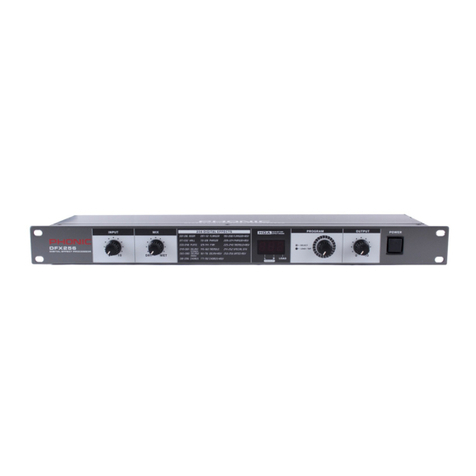
Phonic
Phonic DFX256 User manual
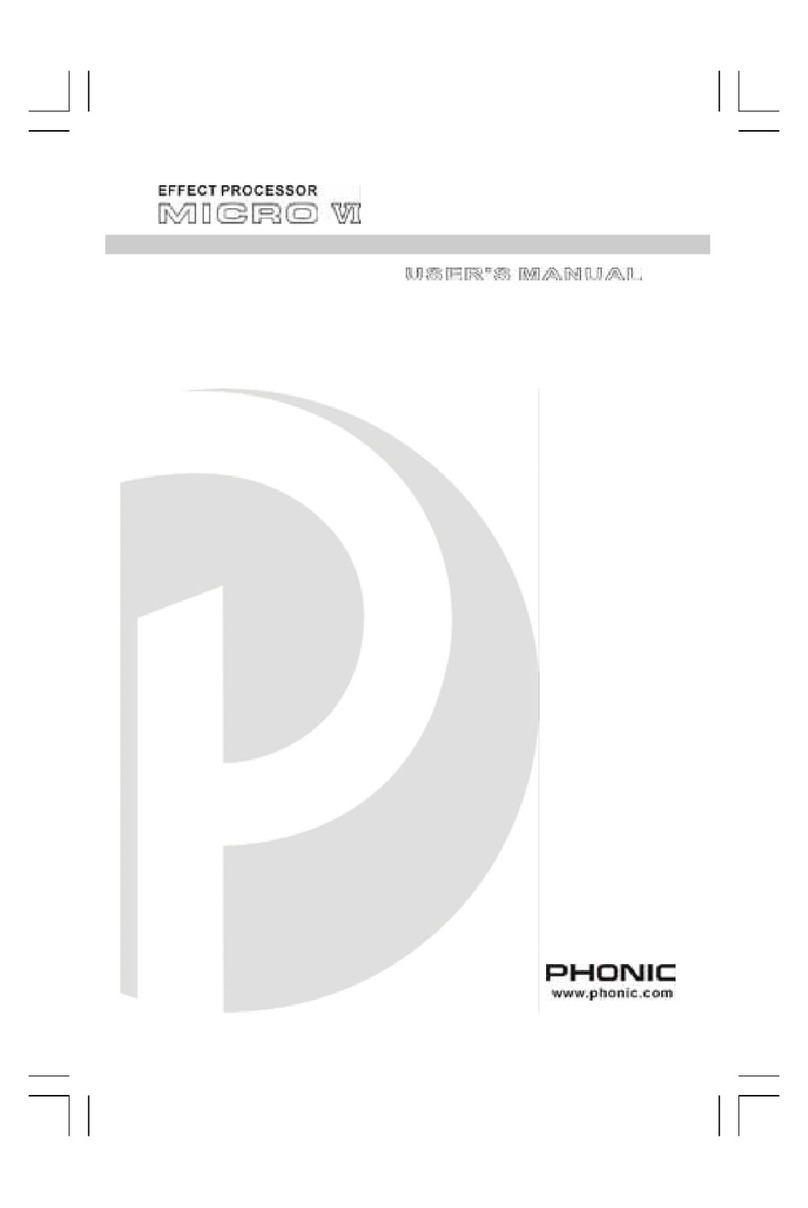
Phonic
Phonic MICRO VI User manual

Phonic
Phonic MM1705a User manual
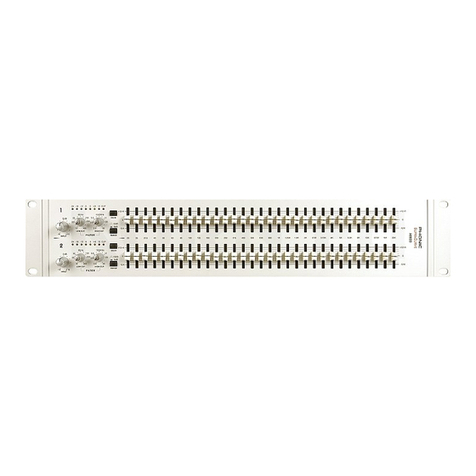
Phonic
Phonic SupraCurve A6600 User manual

Phonic
Phonic DFX256 User manual

Phonic
Phonic FIREFLY 302 USB User manual

